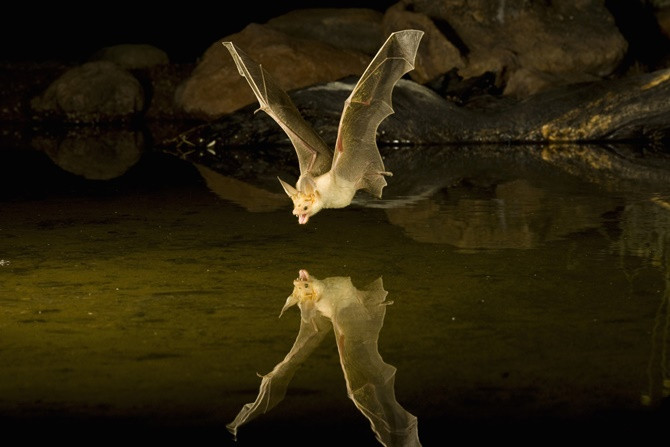Do bats have interference with each other's sound waves to scramble for 'eating pieces'?
According to How Stuff Works, all living things in nature try to gain an advantage when searching for the next meal. Some animals use their size to provide an advantage, while others rely on speed or ability to create a threatening sound. Researchers have recently discovered that even fairly quiet bats have tricks to prevent others from finding bait.
Bats often work and hunt at night. They eat small and quiet prey, like caterpillars and other insects. Although the term "blind as a bat" is widely used, in fact bats are not blind, they only use reliable means more than once to find these tiny dinners.

Bats often work and hunt at night.
When searching for food, the bat emits a series of high-pitched sound waves into the darkness and recovers reflections when touching objects. When a bat hears an echo, it knows a nearby object and moves closer to the object, sending out more probing waves. As the intensity of the sound waves increases, the bat learns that it is very close to the prey and continues to emit sound waves until it reaches the target and catches the prey. The process of finding the location of the target by hearing echoes of sound waves is called "echolocationa" - the method.
In 2014, William Conner of Wake Forest University and colleagues Aaron Corcoran of Wake Forest University used audio and video systems to observe the behavior of bats when they use sound waves. to feed. They found that bats could also use their sound waves for hostile and competitive purposes.
They observed Mexican bats when they hunted tiger butterflies, a favorite of this species. They discovered that bats emitted a specific sound to interfere with the results of the hunting with sound waves of other children. Scientists call this the scanning process. The study concluded that bats emit this sound intentionally to interfere with the hunting process of other bats and create their own advantages.
When the researchers recorded the jamming sound and emitted when other bats searched for bait, they found it affected them. These sounds make 86% of bats hear their target miss. Scientists have tested other sounds such as white noise - White noise is a form of noise created by combining different types of sounds with different frequencies. Imagine that you can combine all the sounds people can hear together, then you'll get white noise - but they hardly affect bats.

In the natural world, sound waves and sound waves are not just for bats.
In the natural world, sound waves and sonar positioning are not just for bats - mammals like dolphins and other whales also use it to find their way. And people have also adopted technology that mimics this process, for example, ships often use sound waves to help them navigate in dark water and to discover what's under the water. Sound waves can help determine the presence of another ship, a dangerous obstacle or underwater animals. During the war, sound waves can help detect enemy submarines or interfere with other ships.
- Sound waves can lead drugs into the body to kill tumors
- The truth about creatures saves billions of dollars
- Can sound waves kill you?
- Makes the matter fly with sound waves
- Avoid annoying noise with sound insulation
- Underwater sound waves can help tsunami warnings earlier
- Ultrasound 'magic' of dolphins can improve current medical techniques
- The sound of water drops
- Bats are also obsessed with sex
- Discover the species of bat that catch ... fish
- Sound waves from Japanese earthquakes hit the universe
- Finding new sound waves accelerates the treatment of lung and diabetes diseases more than 60 times
 Animal 'suffering' after hibernation
Animal 'suffering' after hibernation Why do goats climb well?
Why do goats climb well? Scientists were surprised to see chimpanzees eating turtles
Scientists were surprised to see chimpanzees eating turtles Giant catfish died deadly due to drought in Thailand
Giant catfish died deadly due to drought in Thailand